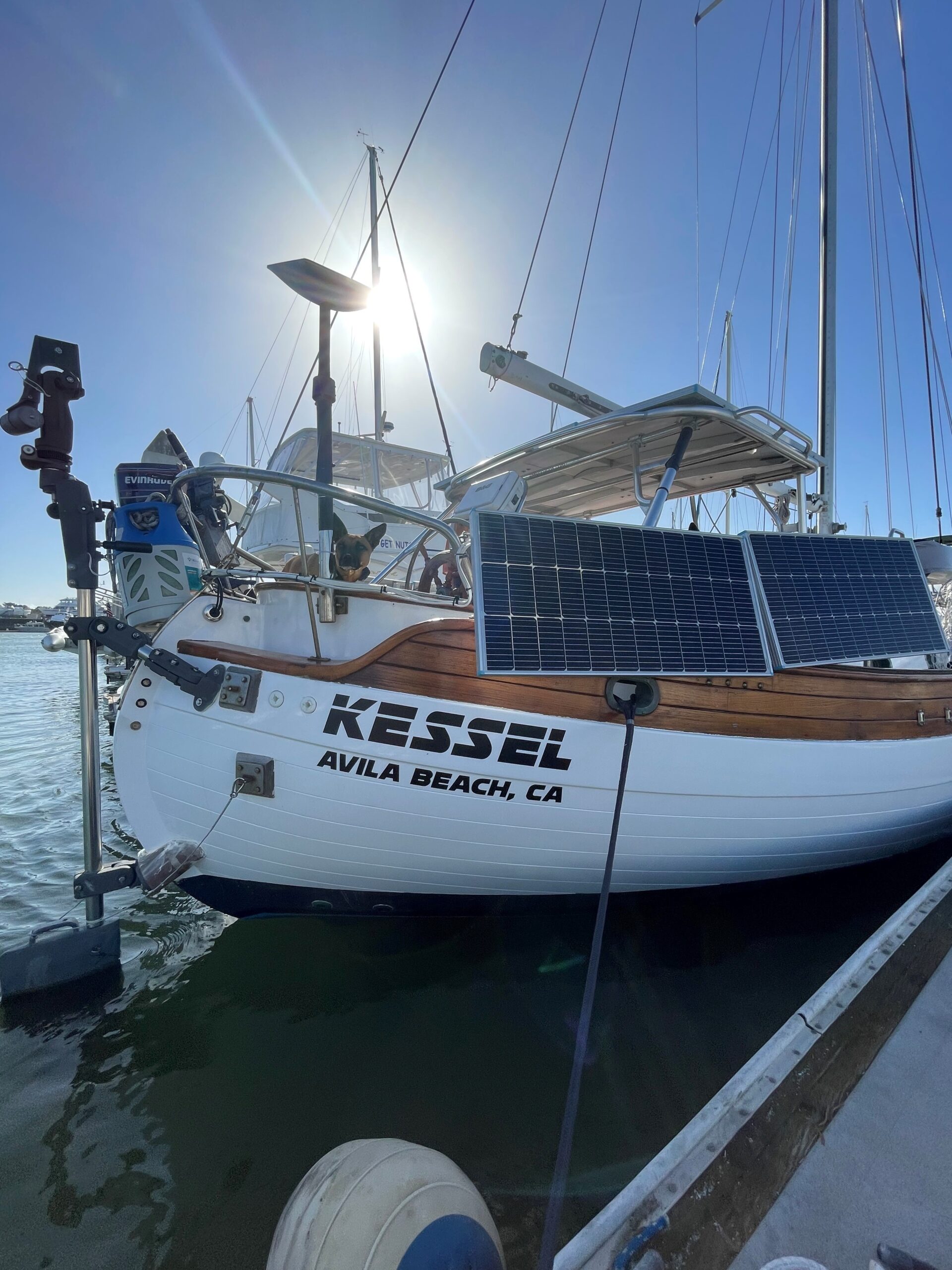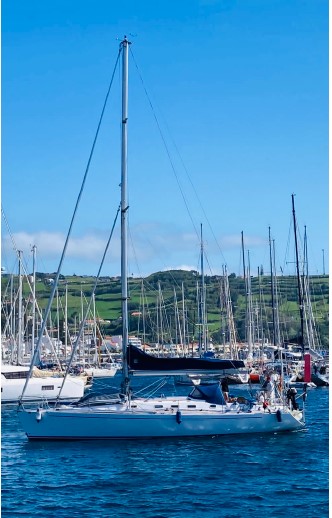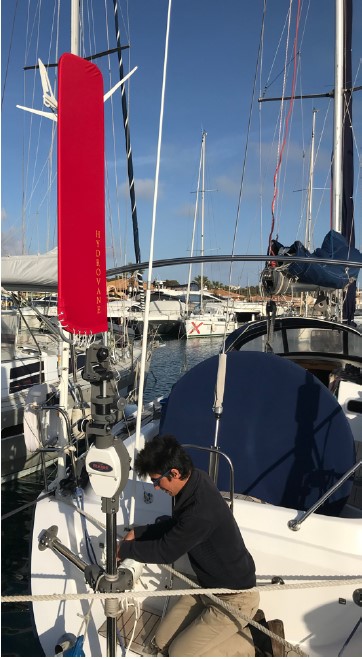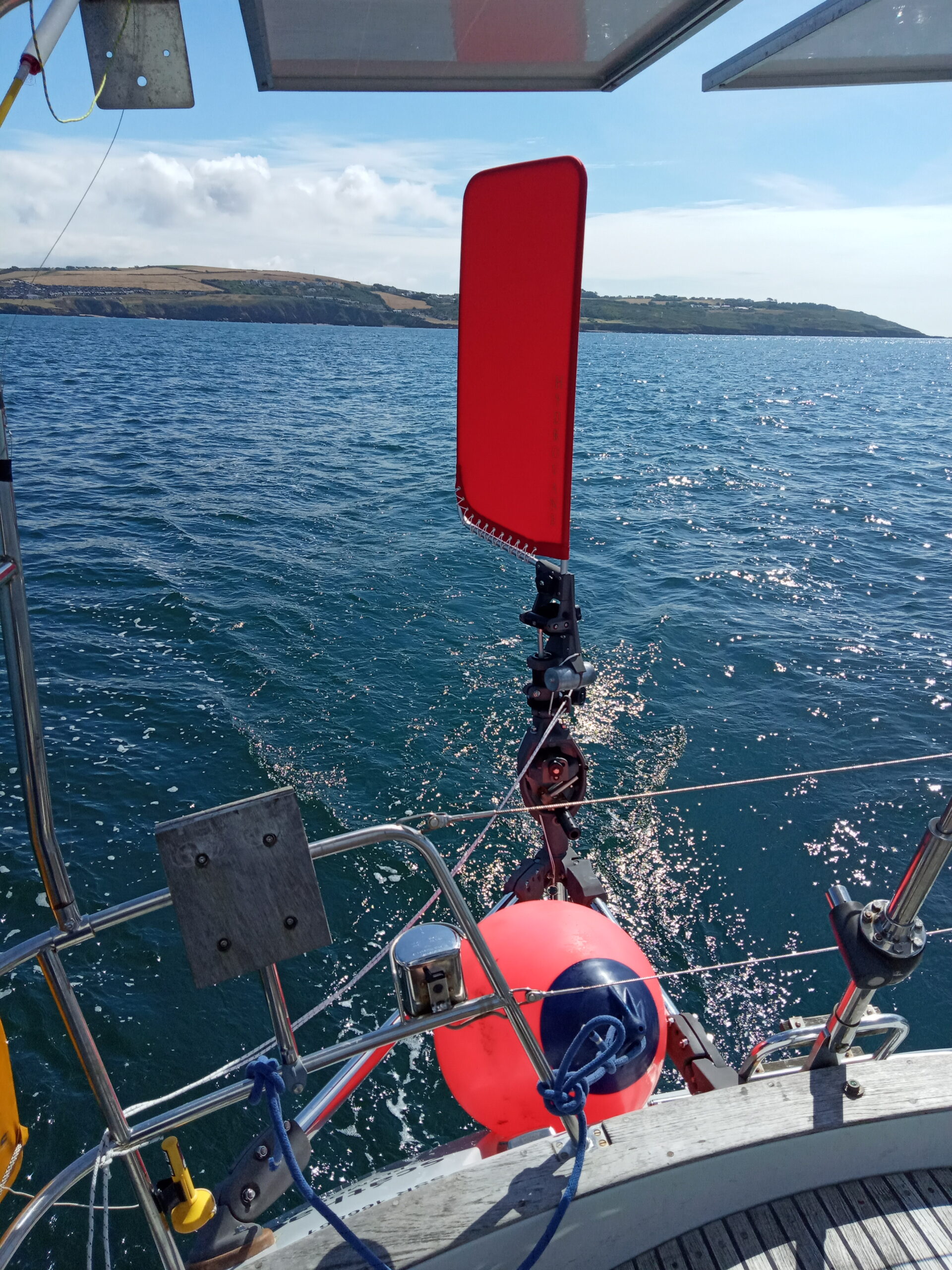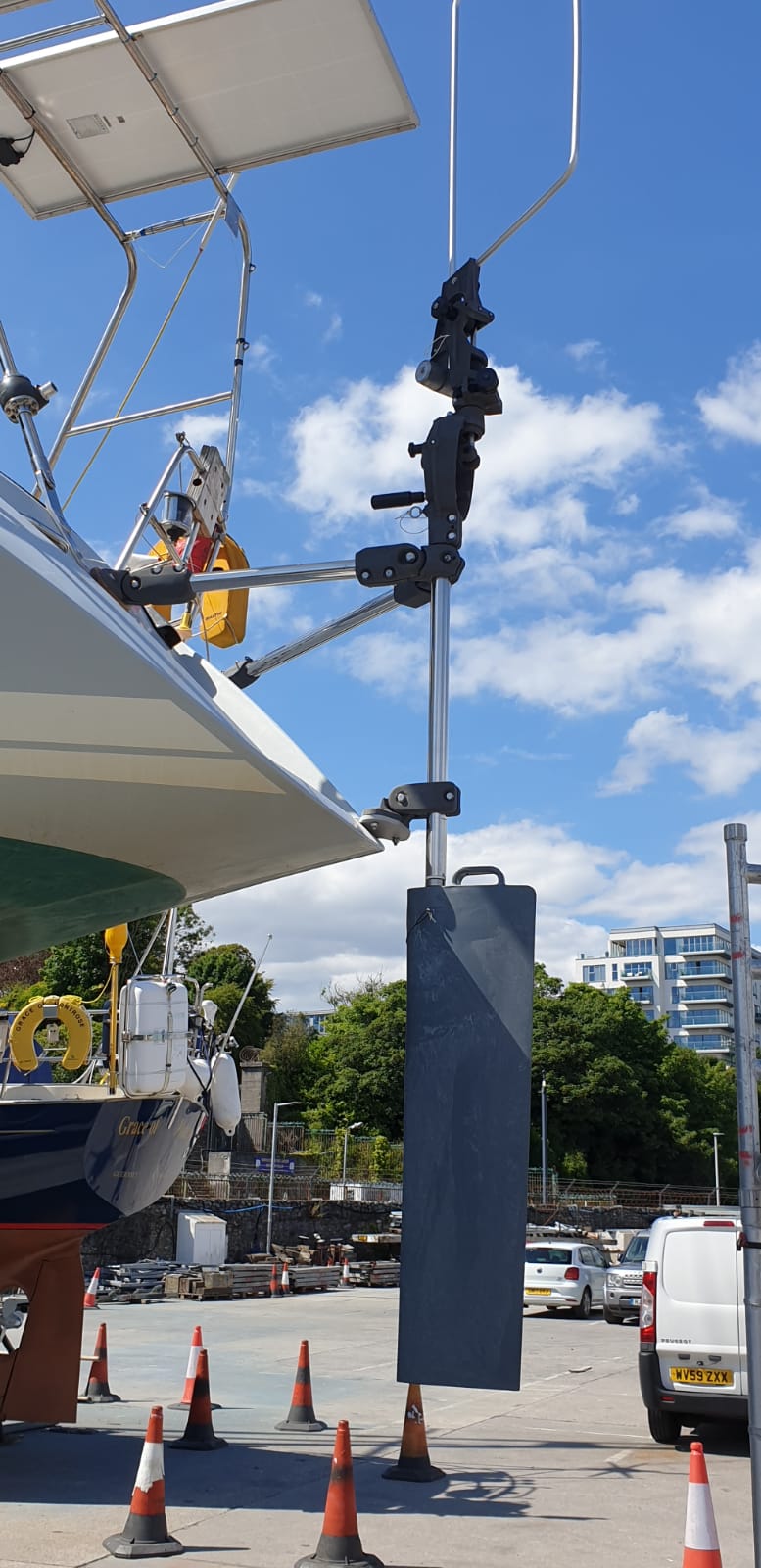Way back in 2016, when we bought The Dream we started planning for this great adventure, we had decided to stick around in the Mediterranean for a few years enjoying life but also preparing for long passages such as the Atlantic crossing.
One of our first upgrades way back in 2017 had been installing a Hydrovane wind pilot (link), this item alone should serve multiple needs like reducing power consumption on passage, it is a pilot that can replace the autopilot altogether, by having its rudder could provide steerage in case of the lost rudder. John had made amazing homework on this finding that this is an item insurance companies like to see on Bluewater sailboats, especially in double-handed crews and together with all that research he had done he had found several cases where people had successfully used the wind pilot while motoring by using a secondary autopilot like a tiller pilot (cheaper than installing another autopilot) with the advantage of with one purchase covering steerage under engine power for the wind vane but also the emergency tiller in case of failure of steerage cabling!

Whilst in the Mediterranean we had barely used the Hydrovane due to the erratic winds, heavy boat traffic and pure laziness, but we had used it a bit in our first year when sailing in the Atlantic and also in our second year in the Western Mediterranean so we already had a good idea of how it worked and its advantages.
For several years it ended up just being that expensive piece of equipment we carry around that makes us look like serious world sailors, and most people don’t understand what the heck is. But during this trip, this expensive piece of hardware would prove itself, pay itself in worthiness and save us a heck of a horrendous time hand steering.
Our Atlantic crossing can be defined in 5 legs, and for all of them the Hydrovane would have been perfect, but to be honest about it we didn’t use it on the first two legs.
The first leg, the sail from Cascais to Madeira we didn’t use because we were passing the infamous Iberian Orca territory right on one of those weeks full of activity, so to preserve the integrity of our wind pilot we followed the current advice given by Hydrovane not to have the rudder installed so that in case of an Orca attack that the boat rudder gets disabled the Hydrovane rudder can be used as backup but because there are reports of Orcas also damaging the Hydrovane rudder during those attacks the current advice is to if possible and viable not to have the rudder installed whilst in Orca rudder destroying grounds.
Once we cleared the area of the attacks we could have installed the Hydrovane rudder and used it, but we were already on a great groove and didn’t bother.
For the second leg from Madeira to the Canaries, we were just lazy, and the boat autopilot is so convenient…
The third leg from the Canaries to Cape Verde would be our first prolonged experience using it. We started using it just after departing Grand Canaria and we used it most of the time.
It was a passage with winds mostly between 120-160AWA (Apparent Wind Angle) and wind speeds of 2-6 Beaufort (4-27 knots), using a 105% Jib on a whisker pole, no mainsail.
Using the Hydrovane most of the time instead of the autopilot meant a significant reduction in our power consumption and a comfortable safe passage.

The fourth leg from Cape Verde to the Fernando de Noronha archipelago off the coast of Brazil was the leg that “paid” for the Hydrovane. Had it not been for this piece of great mechanics we would have been in a big pickle, days from the closest shore.
Late on day 3 of our 10-day passage, we started experiencing difficulties with getting the Hydrovane to steer a course, it would just start wandering erratically due to the amounts of Sargassum seaweed accumulating on the Hydrovane rudder.



Because we were already feeling the tired effects of shorthanded sailing we were not thinking clearly and didn’t realise that this bloody seaweed that was slowing us down so much and giving trouble to the wind pilot would be a big issue for the autopilot also. So, we made the big mistake of switching back to our autopilot for convenience, not realising that although we were not experiencing significant weather helm (after all, the helm was not turning more than usual, it was looking quite balanced), the loads on the boat rudder from the seaweed must have been immense and by middle of day 5, and after 2 days of work our autopilot simply overheated and stop working without any warning signs.
We scrambled to get back onto the Hydrovane as main steering, mentally flogging ourselves for such a stupid mistake!
All we needed to do instead of having turned the autopilot, was to have used the boat hook to clean the Hydrovane rudder of the seaweed.


So now that’s what we were doing anyway as often as every 5 minutes. Something very easy to do but very attention-demanding. The moment the Hydrovane started going off course we just needed to slide the boat hook on the leading edge of the rudder, releasing the seaweed and the Hydrovane would steer us back to the course for a while. This became a full-time job task allowing us very little rest.
Still, much better than the perspective of hand steering for the next five to six days.
If we had tried to hand steer before switching from the Hydrovane to the autopilot it would have been crystal clear the immense pressure being exerted on the rudder.
Despite being back at steering with the Hydrovane quite successfully, the failure of the autopilot presented a huge problem. When we reached the doldrums where motoring is pretty much guaranteed we would need a pilot for the engine to avoid a minimum of 2 days of hand steering.
That’s where a secondary tiller autopilot that we had bought back in 2017 at the same time we installed the Hydrovane would come into play.
Despite the conditions on board resulting from the swell and waves paired with our slow speed, John built a simple structure where to mount the tiller pilot using our boarding plank and a few more bits and pieces, and voila , it was almost as if we had never lost the main autopilot. We could even use the tiller pilot under sail in light winds.

Don’t think these tiller pilots are very suitable for a boat as big as us under sail using the main rudder, but the Hydrovane rudder seems to work just like a “feathering” rudder allowing us to steer very efficiently.
Despite the failure caused by our fatigue that led to equipment fatigue, preparation meant we had a backup plan that worked.
As I mentioned before at the very beginning of this post, as a result of John’s research we bought a Raymarine ST2000 tiller autopilot way back in 2017. We had been lucky enough to have found it on sale at one of the chandleries in Lisbon while we were preparing The Dream for us to move on board. For years I had nagged John about the need of preparing the set-up for this pilot so if we ever needed it, all would be ready to simply switch from one autopilot system to the other, of course, life constantly got in the way, and other much more important projects took priority over our attention and efforts.
The tiller pilot sat for years on its box in one of the lockers. Annoying me every time I went to get something from that locker or every time we serviced and inspected the rudder, quadrant and steering cable system. The view of that box was a constant reminder of yet another To Do item that seemed to always slip off the list without being addressed
Well unfortunately now that box would have to get out of the locker, and the solution was found fast because once arrived the doldrums we could no longer count on the Hydrovane to steer us to the non-existing wind.
John had a plan, something I guess he had already thought about previously, maybe on one of the many occasions the tiller pilot topic add come to the discussion table.
John planned to use our boarding plank (which happens to have a very peculiar size), to use as support for the tiller mounting base.
Our boarding plank is the exact size needed to tie down between the starboard pushpit inner bar and the bar on the BBQ/stern seat. This didn’t happen by mere luck this was John’s idea all this time.
The first step was to drill the necessary holes on both ends of the plank to be able to secure it properly. It was also needed to create a way to prevent the board from changing heights regarding the Hydrovane handle and to ensure the level of the top edge. For that John used bits of thick marine ply that we had removed when adjusting the sail locker false floor that hides the bow thruster, John screwed those to the plank allowing them to sit in the seat making sure this way the plank was correctly levelled and secured.
For the actual mounting, John decided to use an extra 8mm thick aluminium plate we had bought as a spare as part of the hardtop project and as material for reinforcement of the cleats.


All this was reasonably easy to install despite the motion on board being very much like riding a mechanical bull.
To ensure the stability of the aluminium plate we needed to create a thicker base for it to be installed, to achieve that we used some offcuts of the same wood used for the boarding plank that we still had from a decorative project. The challenge was that without 240v using non-battery-operated electrical tools was limited unless we ran the generator, but again the idea of running the power tool needed for this job was just not appealing at all. The motion caused by the choppy sea state meant it was reasonably unwise to do such, so the option was to use a handsaw to cut the wood piece in half giving us the needed straight edge now that was a hard task.

I proceeded with that task whilst John worked on the electrical part of the installation. We needed enough wire to run from the main helm station to the Battery Bank, the Circuit Board or the Engine Starter Battery. Given the “work” conditions the Engine Starter Battery would be the “victim” due to proximity and easy access.
There was another task for me before the final assembly of all bits, the tiller pilot required a fuse, the only fuse case holder we had to fit a fuse of the required amperage was not a right fit for the only fuse close enough to the needed rating (it needed 12 amps, and we only had 10 amps), the fuses I had were spares for the circuit board while the case holder was for a different project that used slightly bigger blade fuses.



A bit of tough love with a file on 10A fuse would have to do the trick, a delicate butchering job.
By the time all was assembled it looked like a nice Frankstein of a job!
The moment of truth was testing if all of it would hold and if the tiller was strong enough to steer us or not.
We powered it on, secured the wheel in place, and turned the tiller pilot on while motoring at low RPMs then slowly increasing up to 1800 RPM. The test was a success we could motor through the doldrums without having to hand steer!
That was excellent news.

With the progressive use of our newly installed spare pilot, we gained confidence in its abilities but also become aware of its fragility. This solution would have to work not only for the Atlantic crossing to Fernando de Noronha and then the Brazilian mainland but down to São Salvador where we would try and see if we could fix our main autopilot.
We were ecstatic with our choice of the Hydrovane as backup steering, it had proved itself as a wind pilot, as a spare steering autopilot system for when under the engine and even if under sail without using it as a wind pilot. A truly remarkable piece of equipment and investment.
The Dream is a true world sailing vessel.
And the label on the box where the Hydrovane parts came in never felt truer!

*** All the content provided on this post is for informational purposes only, not replacing any additional research or contact with relevant suppliers and technicians. The owners of this website will not be liable for any errors or omission in this information nor the availability of information found when following any link on this post.
***The Dream is not affiliated or sponsored by Hydrovane or by any associated dealer, this blog post is based solely on our experiences with the product.
***In the spirit of sharing our dreams and experiences we have shared this blog post in the NOFOREIGNLAND.COM website sailors community.

 Dufour 500 GL
Dufour 500 GL